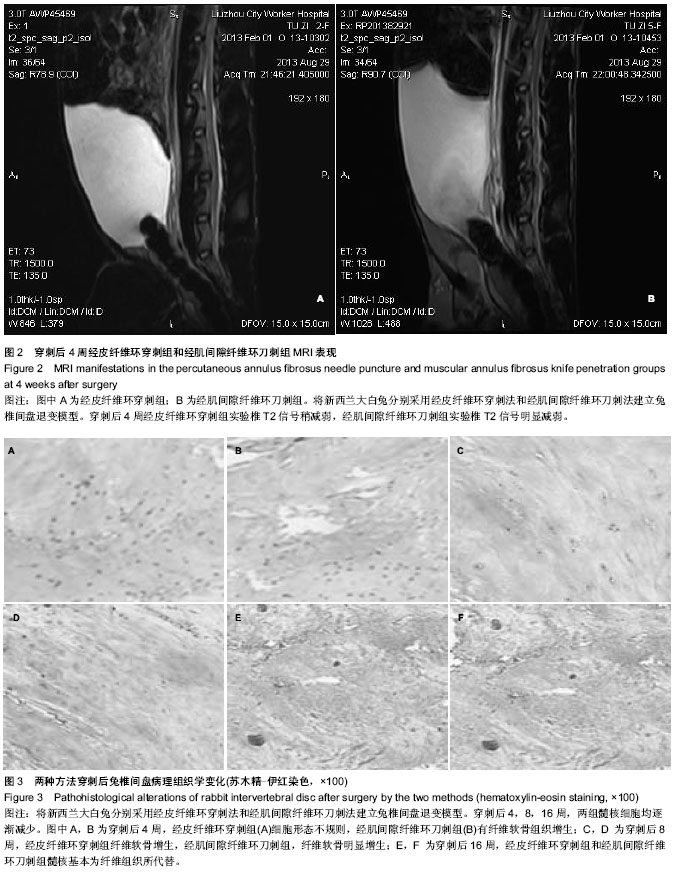| [1] Key J, Ford L. Experimental intervertebral-disc lesions. J Bone Joint Surg. 1948;30(3):621-630.[2] 郭常安,胡有谷,吴新彦,等.腰椎间盘退变动物模型的建立[J].中华外科杂志,2000,38(7):548- 551.[3] 吴健,唐天驷,王根,等.兔腰椎间盘退变模型的建立及影像学分析[J].苏州大学学报,2007,27(4):552-554.[4] 蒋新华,张伶,陈建宇,等.透视引导下穿刺构建兔椎间盘退变模型的影像和病理变化[J].中国组织工程研究与临床康复,2011, 15(48):8931-8934.[5] Zhou RP, Zhang ZM, Wang L, et al. Establishing a disc degeneration model using computed tomography-guided percutaneous puncture technique in the rabbit. J Surg Res. 2013;181(2):e65-74. [6] 辛龙,韩国灿,赵凤东,等.兔纤维环损伤椎间盘退变模型观察神经长入的实验研究[J].浙江大学学报(医学版),2009,38(5):485-492.[7] 王靖,唐天驷,姚啸生,等.纤维环穿刺诱导椎间盘退变动物模型的实验研究[J].中国脊柱脊髓杂志,2006,16(4):284-287.[8] 谢卯,熊蠡茗,周建国,等.椎间盘退变模型研究进展[J].国际骨科学杂志,2009,30(2):124-126.[9] Stokes IA, Iatridis JC. Mechanical conditions that accelerate intervertebral disc degeneration: overload versus immobilization. Spine (Phila Pa 1976). 2004;29(23): 2724-2732.[10] Masuda K, Aota Y, Muehleman C, et al. A novel rabbit model of mild, reproducible disc degeneration by an anulus needle puncture: correlation between the degree of disc injury and radiological and histological appearances of disc degeneration. Spine (Phila Pa 1976). 2005;30(1):5-14.[11] Hutton WC, Murakami H, Li J, et al. The effect of blocking a nutritional pathway to the intervertebral disc in the dog model. J Spinal Disord Tech. 2004;17(1):53-63.[12] Oda H, Matsuzaki H, Tokuhashi Y, et al. Degeneration of intervertebral discs due to smoking: experimental assessment in a rat-smoking model. J Orthop Sci. 2004;9(2):135-141.[13] Sahlman J, Inkinen R, Hirvonen T, et al. Premature vertebral endplate ossification and mild disc degeneration in mice after inactivation of one allele belonging to the Col2a1 gene for Type II collagen. Spine (Phila Pa 1976). 2001;26(23): 2558-2565.[14] Liu HF, Zhang H, Qiao GX, et al. A novel rabbit disc degeneration model induced by fibronectin fragment. Joint Bone Spine. 2013;80(3):301-306. [15] Moss IL, Zhang Y, Shi P, et al. Retroperitoneal approach to the intervertebral disc for the annular puncture model of intervertebral disc degeneration in the rabbit. Spine J. 2013; 13(3):229-234. [16] Xin L, Han GC, Zhao FD, et al. In vivo study of innervation of degenerative intervertebral discs in rabbit anular-injury model. Zhejiang Da Xue Xue Bao Yi Xue Ban. 2009;38(5):485-492.[17] Han B, Zhu K, Li FC, et al. A simple disc degeneration model induced by percutaneous needle puncture in the rat tail. Spine (Phila Pa 1976). 2008;33(18):1925-1934. [18] Yoon SH, Miyazaki M, Hong SW, et al. A porcine model of intervertebral disc degeneration induced by annular injury characterized with magnetic resonance imaging and histopathological findings. Laboratory investigation. J Neurosurg Spine. 2008;8(5):450-457.[19] 林鸿宽,叶君健.纤维环损伤诱导兔椎间盘退变模型[J].解剖学杂志,2008,31(5):699-702.[20] 胡鹏,刘勇,胡有谷,等.一种羊腰椎间盘退变模型的建立[J].青岛大学医学院学报,2007,43(2):167-168.[21] Holm S, Holm AK, Ekström L, et al. Experimental disc degeneraIion due to endplate injury. J Spinal Disord Tech. 2004;17(1):64-71.[22] Cinotti G, Della Rocca C, Romeo S, et al. Degenerative changes of porcine intervertebral disc induced by vertebral endplate injuries. Spine (Phila Pa 1976). 2005;30(2):174-180.[23] Greg Anderson D, Li X, Tannoury T, et al. A fibronectin fragment stimulates intervertebral disc degeneration in vivo. Spine (Phila Pa 1976). 2003;28(20):2338-2345.[24] Nakamura T, Iribe T, Asou Y, et al. Effects of compressive loading on biomechanical properties of disc and peripheral tissue in a rat tail model. Eur Spine J. 2009;18(11):1595-1603.[25] 熊晓芊,邵增务,裴洪,等.可控轴向压力致兔腰椎间盘退变模型的建立及评价[J].中国病理生理杂志,2008,24(10):2077-2080.[26] 李振宙,侯树勋,刘宁,等.新型山羊腰椎间盘突出模型的建立[J].中华骨科杂志,2007,27(11):838-843.[27] Lotz C. Animal models of intervertebral disc degeneration: lessons learned. Spine. 2004;29(23):2742-2750.[28] 孔杰,王子轩,季爱玉,等.应用微创技术建立恒河猴腰椎间盘早期退变模型[J].中华外科杂志,2008,46(11):835-838.[29] Seol D, Choe H, Ramakrishnan PS, et al. Organ culture stability of the intervertebral disc: rat versus rabbit. J Orthop Res. 2013;31(6):838-846.[30] 吴靖平,陈统一,陈中伟,等.双后肢大鼠椎间盘退变动物模型的建立[J].中华实验外科杂志,2004,21(1):105-107.[31] O’Connell GD, Vresilovic EJ, Elliott DM. Comparison of animals used in disc research to human lumbar disc geometry. Spine. 2007;32(3):328-333.[32] Elliott DM, Sarver JJ. Young investigator award winner: Validation of the mouse and rat disc as mechanical models of the human lumbar disc. Spine. 2004;29(7):713-722.[33] Vo N, Seo HY, Robinson A, et al. Accelerated aging of intervertebral discs in a mouse model of progeria. J Orthop Res. 2010;28(12):1600-1607.[34] Demers CN, Antoniou J, Mwale F. Value and limitations of using the bovine tail as a model for the human lumbar spine. Spine. 2004;29(24):2793-2799.[35] Gruber HE, Gordon B, Williams C, et al. Vertebral endplate and disc changes in the aging sand rat lumbar spine: Cross-sectional analyses of a large male and female population. Spine. 2007;32(23):2529-2536.[36] Cappello R, Bird JL, Pfeiffer D, et al. Notochordal cell produce and assemble extracellular matrix in a distinct manner, whichmay be responsible for the maintenance of healthy nucleus pulposus. Spine. 2006;31(8):873-882.[37] Sowa G, Valada G, Studer R, et al. Characterization of intervertebral disc aging: Longitudinal analysis of a rabbit model by magnetic resonance imaging, histology, and gene expression. Spine. 2008;33(17):1821-1828.[38] 崔运能,李绍林,金大地,等.肌间隙入路腰椎间盘退变模型的构建[J].南方医科大学学报,2012;32(3):404-408. |

